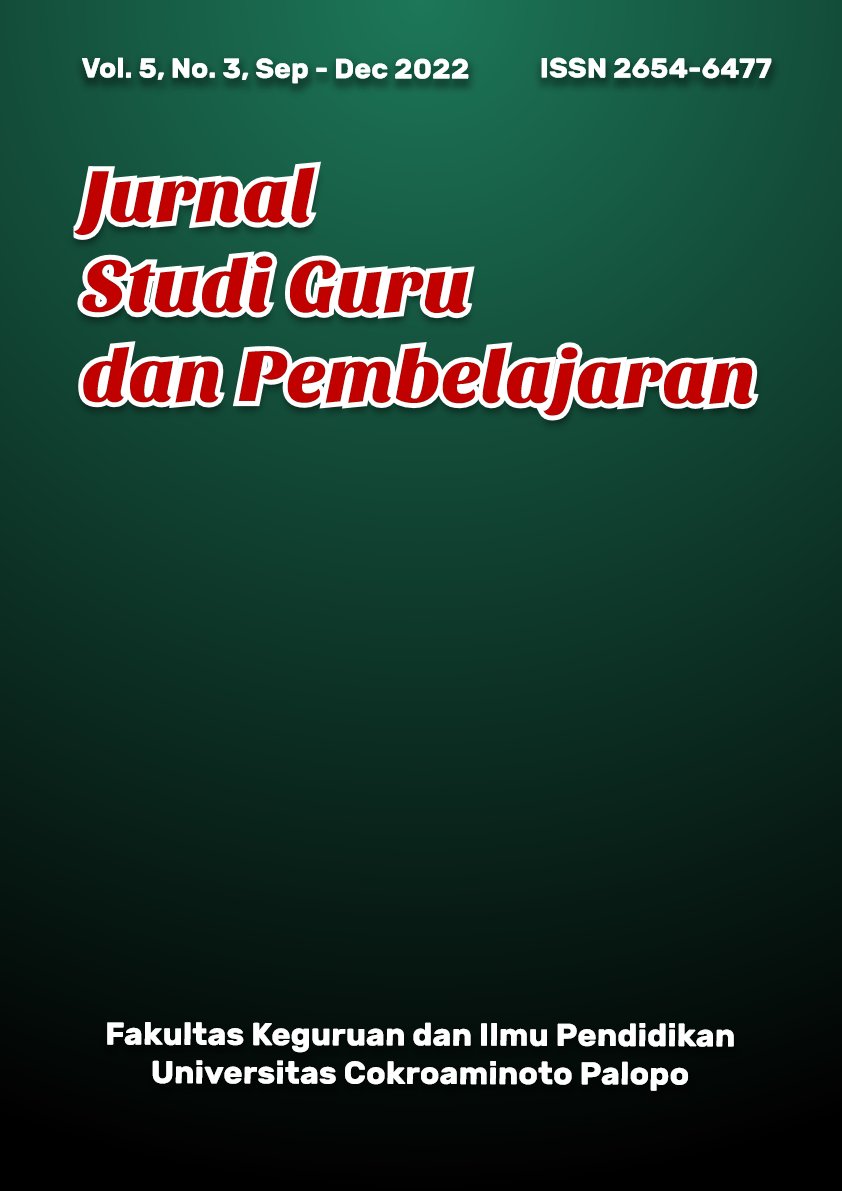Desain Media Pembelajaran Prakarya Berbasis Smart Apps Creator
DOI:
https://doi.org/10.30605/jsgp.5.3.2022.1884Keywords:
Media Pembelajaran, Smart Apps Creator, Prakarya, Four D Model, SMPAbstract
The aims of this study is to produce learning media in Android-based craft subjects through valid and practical smart apps creator applications at SMPN 12 Bulukumba. The research method used is the Research and Development (R&D) method. The development model used refers to the 4D development model (Four D-Model) consisting of 4 stages, namely: define, design, development and dessimeninate. However, this research was only carried out at the development stage. Because this research is only limited to developing and producing Android-based learning media products through smart application maker applications. The research was conducted in class VII SMPN 12 Bulukumba with 30 students and 1 teacher. The research instruments used were media and material expert validation sheets, student and teacher response questionnaires. The data collection technique used was the validation test and student response questionnaires. The results of the development show that learning media based on smart apps creator based on the assessment aspect obtained an average value of 3.70 with a very valid category. Meanwhile, the assessment of material experts is also in a very valid category with an average value of 3.70. The results of the small group trial assessment obtained an average value of 3.27 in the good category. While the results of the small group test obtained an average of with practical criteria while in the limited field test an average score of = 3.44 with very practical features and for teacher responses obtained an average average =3.65 with very practical features. Based on the results of research conducted through the development process, the researchers concluded that the learning media developed were valid and practical to use
Downloads
References
Abdul, K. (2018). Media Dan Teknologi Pembelajaran. Yogyakarta: CV. Andi Offset.
Afriza. (2019). Pengembangan Media Pembelajaran Berbasisi aplikasi Android. Jambi: Pustaka Pelajar
Budyastomo, A. W. (2020). Gim edukasional untuk pengenalan tata surya. Teknologi: Jurnal Ilmiah Sistem Informasi, 10(2), 55-66. DOI: https://doi.org/10.26594/teknologi.v10i2.1955
Chandrawati, S. R. (2018). Pemanfaatan E-learning dalam Pembelajaran. Bandung: Pustaka Setia Bandung.
Dyah, Kusuma Wardhani (2022) Pengembangan Mobile Learning Berbasis Sac (Smart Apps Creator) Sebagai Media Pembelajaran Fisika Tingkat Sekolah Menengah Atas. Undergraduate thesis, UIN Raden Intan Lampung.
Febriyanthi, N. K. N., & Abadi, I. B. G. S. (2022). Validasi Media Pembelajaran SAC Berbasis PPBL Guna Meningkatkan Atensi Siswa Pada Materi Organ Gerak Hewan Dan Manusia. Jurnal Pendidikan dan Konseling, 4(3), 740-751.
Ferlianti, S., Rusdiana, D., Suwarma, I. R., & Nurbani, A. R. (2022). Pengembangan Multimedia Pembelajaran Interaktif SAC pada Materi Tekanan Hidrostatis. Jurnal Pendidikan Indonesia, 3(1), 13-24. DOI: https://doi.org/10.36418/japendi.v3i1.479
Hamzah. (2019). Metode Penelitian Research & Developmen. Bandung: Alfabeta.
Khasanah, K., & Rusman, R. (2021). Development of Learning Media Based on Smart Apps Creator. Al-Ishlah: Jurnal Pendidikan, 13(2), 1006-1016. DOI: https://doi.org/10.35445/alishlah.v13i2.549
Muhlas, M., & Marwani, L. (2020). Development of e-learning Smart Apps Creator (SAC) learning media for selling employees on paid tv. Akademika: Jurnal Teknologi Pendidikan, 9(02), 129-143. DOI: https://doi.org/10.34005/akademika.v9i02.819
Mahuda, I., Meilisa, R., & Nasrullah, A. (2021). Pengembangan Media Pembelajaran Matematika Berbasis Android Berbantuan Smart Apps Creator Dalam Meningkatkan Kemampuan Pemecahan Masalah. AKSIOMA: Jurnal Program Studi Pendidikan Matematika, 10(3), 1745. DOI: https://doi.org/10.24127/ajpm.v10i3.3912
Nasir, N. (2020). The Development Oo Web-Based Islamic Education Learning Media (PAI) In VIII Class of Unismuh SMP Makassar. Akademika: Jurnal Teknologi Pendidikan, 9(01), 127-138. DOI: https://doi.org/10.34005/akademika.v9i01.813
Nasir, N., & Galung, E. A. H. (2021). Pengaruh Media Pembelajaran E-Learning Berbasis Gnomio Terhadap Hasil Belajar Siswa. Jurnal Literasi Digital, 1(2), 130-138. DOI: https://doi.org/10.51574/jrip.v1i2.26
Pujiyono, W., Hendriana, Y., & Susanti, I. D. (2016, October). Interactive learning media based on RPP ICT. In 2016 International Conference on Information Technology Systems and Innovation (ICITSI) (pp. 1-5). IEEE. DOI: https://doi.org/10.1109/ICITSI.2016.7858218
Prokoso. (2020). Pengembangan Media Pembelajaran Smart Apps Creator. Ilmu Pendidikan, 150-160.
Rusman, Kurniawan & Cepi Riyana. (2018). Pembelajaran Berbasis Teknologi Informasi dan Komunikasi. Jakarta: Grafindo Persada.
Sugiyono. (2019). Metode Penelitian Pendidikan. Bandung: Alfabeta.
Downloads
Published
How to Cite
Issue
Section
License
In submitting the manuscript to the journal, the authors certify that:
- They are authorized by their co-authors to enter into these arrangements.
- The work described has not been formally published before, except in the form of an abstract or as part of a published lecture, review, thesis, or overlay journal.
- That it is not under consideration for publication elsewhere,
- That its publication has been approved by all the author(s) and by the responsible authorities – tacitly or explicitly – of the institutes where the work has been carried out.
- They secure the right to reproduce any material that has already been published or copyrighted elsewhere.
- They agree to the following license and copyright agreement.
License and Copyright Agreement
Authors who publish with JSGP agree to the following terms:
- Authors retain copyright and grant the journal right of first publication with the work simultaneously licensed under Creative Commons Attribution License (CC BY-SA 4.0) that allows others to share the work with an acknowledgement of the work's authorship and initial publication in this journal.
- Authors are able to enter into separate, additional contractual arrangements for the non-exclusive distribution of the journal's published version of the work (e.g., post it to an institutional repository or publish it in a book), with an acknowledgement of its initial publication in this journal.
- Authors are permitted and encouraged to post their work online (e.g., in institutional repositories or on their website) prior to and during the submission process, as it can lead to productive exchanges, as well as earlier and greater citation of published work.














